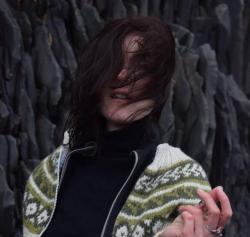“I wanted to tell this story because I think it’s highly relevant,” says Kristín Amalía Atladóttir, “not only as a reaction to the Me Too revolution. It’s also a kind of reaction to the very uncomfortable things that are developing in America and Poland, where women’s reproductive rights are being limited.”
Kristín Amalía is the director of Egilsstaðir’s cultural centre, Sláturhúsið. She is also the originator of this summer’s multimedia storytelling exhibition ‘Sunnifa.’ While literature is not the usual focus of Sláturhúsið’s programme, this exhibition runs simultaneously with Kristín Gunnlaugsdottir’s exhibition of embroidered text.

The story of Sunnifa
Kristín Amalía elaborates on her exhibition’s raison d’être: “This is a 300-year-old story about Sunnifa, who became a victim of strict laws regarding incest, unwanted pregnancies, and killing babies. It’s an incredible story that took place over twenty years. Very little is known apart from official documentation.”
To prepare Sunnifa’s story in an exhibition space, Kristín collaborated with a designer and an illustrator. “We only had the story itself, no visuals. So the challenge was to make an exhibition that would sustain interest although it was mostly text-based.”

Historical whodunit
Kristín Amalía’s research into Sunnifa’s life revealed that the legal case was the primary source indicating her existence, as there were otherwise no birth or death records.
“She’s nowhere on record. We’re trying to bring her to life, to give her a face and a presence. All the men are silhouettes; she and the children are the only ones with faces in the exhibition.”
The exhibition includes a book written by Kristín Amalía, with all of the facts that are known about Sunnifa and her legal case. “When there’s a bit of bias, I put a footnote. There is a whodunit in the end. You don’t want to influence people. They can collect all the facts that are known and make up their own minds.”

Text meets textile
For her exhibition ‘ég er að deyja’, visual artist Kristín Gunnlaugsdóttir embroiders common phrases on large wall canvases. According to Sláturhúsið’s director, “these sentences come from the mouths of kids and teenagers, but have a broader relevance.
“Kristín Gunnlaugsdóttir picked up sentences and gave them a different context, like ‘I wish she was dead.’ Teenagers do say that but, like I said, it has a different context in relation to the Sunnifa exhibition.”
Each canvas focuses on a word or phrase, embroidered in red thread on a burlap-coloured background. One canvas centers ‘mamma mín’ (Icelandic for ‘my mother’), while another displays a phrase that translates as ‘just as good I am not beautiful’. The sentences are terse, complex with meaning despite their succinctness. Red thread resonates as life-blood, anger, love, or an editor’s red pen.

Ég er að deyja
On one canvas, Kristín repeatedly embroidered the phrase ‘ég er að deyja’ (‘I am dying’, in English). The capacity to write the sentence is slowed down dramatically by using needle and thread to embed it on the canvas. The slower engagement with letters and words moves towards exhaustion through the repetition of this phrase.
“As it progresses,” Kristín Amalía explains, “you’re moving closer to the meaning of the sentence. ‘Ég er að deyja.’ We’re dying from heat, we’re dying from whatever. I think this is the only true statement we can make.”
Kristín Amalía stresses the interconnections between her Sunnifa exhibition and Kristín’s work. “‘Ég er að deyja’ is in direct relation to the Sunnifa exhibition, which is all about death—death is hanging over her head for the twenty years of the story.”
Ekki, an echo
Yet another canvas bears the sole word ‘ekki’, which means ‘not’ in Icelandic. “When you’re crying,” says Kristín Amalía, “the gasping sound, this is ‘ekki’. Possibly it relates to ‘echo’.”
Kristín Amalía sources an intertextual connection between the prominence of ‘ekki’ in the exhibition and its relationship with sorrow. “There was a book of poetry published last Christmas called ‘Requiem’ by Gerður Kristný. It’s about sexual violence, an incestuous incident that happened twenty years ago when Gerður was a journalist. In the book, Gerður writes about church and benches, which rhymes in Icelandic. ‘In the church of doom and sorrow, there are benches made out of sorrow.’ I don’t know if Kristín was aware of Gerður’s lines when she was playing with this word, but it resonates.”
After the flood
“I’m working on two other projects related to the ‘Sunnifa’ exhibition,” Kristín Amalía shares. “There was a woman named Halldóra born in Seyðisfjörður who was drowned in the valley. She was innocent. I’m working to get her a posthumous pardon. This is difficult because there’s no such law in Iceland. I’m waiting for a phone call to see what’s best with the government, whether to create new laws or a new category of pardoning posthumously. Hopefully, I’ll get this through parliament and we’ll be able to put up a big memorial, using her as a representative of all of these women who were victims of sexual abuse.”
Ekki. It makes one feel emotional.
‘Sunnifa’ and ‘ég er að deyja’ are on display at Sláturhúsið in Egilsstaðir until September 15th
Buy subscriptions, t-shirts and more from our shop right here!


















